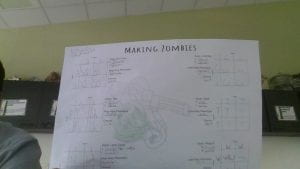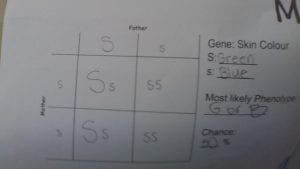My Genetics Summary
Hey everyone! For the past few weeks, I’ve been learning a lot about genetics, and I want to share what I’ve discovered.
First off, what is DNA? DNA stands for Deoxyribonucleic acid, and it’s found in every living thing! Each living organism has trillions of cells, and inside those cells, we have chromosomes. Humans have about 23 pairs of chromosomes, which means we have 46 in total. When parents have a child, the child gets 23 chromosomes from each parent, making a perfect pair!
Now, let’s talk about DNA’s shape, it looks like a double helix! The building blocks of DNA are called nucleotides, which have three parts: phosphate, sugar, and a base. There are four base pairs that make up the steps of the helix: A, T, C, and G. C pairs with G, and A pairs with T.
Next up is the gene. A gene is a section of DNA that determines traits, like hair color. Alleles are different versions of a gene. For example, one allele can code for blonde hair, while another can code for brown hair.
Inheritance is how these traits get passed down from parents to their kids. For instance, if one parent has blue eyes and the other has brown, we can use Punnett squares to figure out what eye color the child might have. A recessive allele is shown with a lowercase letter (like “x”), and a dominant allele is shown with a capital letter (like “A”).
Using a Punnett square, we can place the parents’ alleles on the sides and find out the possible traits of their offspring!
1: Here are some words that I have learnt:
DNA: The genetic code that makes us who we are
Organism: Any living thing, like plants, animals, or humans
Cells: The tiny building blocks that make up all living things
Nucleus: The center of a cell that contains important information
Chromosomes: Strands found in the nucleus that hold our DNA
Offspring: A baby or young version of a living thing
Double Helix: The cool twisted shape of DNA
Nucleotide: A piece of DNA made up of three parts: phosphate, sugar, and a base
4 Based Pairing Rule: A and T go together because they are sharp letters, while G and C pair up because they are curved letters.
Genes: A part of DNA that helps decide specific traits in our bodies, like hair color.
Alleles: Different versions of the same gene. For example, one allele can give you blue eyes, while another can give you brown eyes.
Phenotype: This is what you can see on the outside, like your hair or eye color.
Genotype: This is the combination of two alleles you inherit from your parents, which is like the hidden instructions inside you.
Inherit & Inheritance: This is about how kids get different alleles from their parents. It’s the way traits get passed down through generations.
Punnett Squares: A tool that helps you figure out which traits the kids might inherit from their parents.
Recessive Allele: This is shown with a lowercase letter, like “a.”
Dominant Allele: This is shown with a capital letter, like “A.”
Purebred: When an organism has two of the same kind of alleles, either both dominant or both recessive, like BB or bb.
The next thing I want to talk about is traits. A trait is something that describes an animal and is passed down through its genes. Now, when we talk about animals, they use something called natural selection to help them survive. So, what is natural selection?
Natural selection is the process by which nature chooses the best traits for animals to survive and have babies. It helps them escape from predators in the wild. For example, if an animal has a trait that helps it hide better, it’s more likely to stay safe and reproduce. Then, that trait can be passed on to its babies.
This is why animals evolve over time. They need to survive longer and adapt quickly to their surroundings!
2: Here are even more words that I have learnt:
Traits: Traits are the characteristics and features that make living things unique. These can include things like eye color, fur patterns, or even behaviors.
Natural Selection: Natural selection is a process by which nature decides which traits are good for survival. Animals with helpful traits are more likely to live longer and have babies, passing those traits on to the next generation.
Survive: To survive means to live and stay alive, even when faced with challenges like finding food or avoiding danger.
Reproduction: Reproduction is how living things create new life, or offspring. This can happen in lots of ways, such as animals having babies or plants creating seeds.
Adapt: Adapting means changing or getting used to new things in the environment. Over time, animals and plants can develop new traits that help them survive better in their surroundings.
Predators: Predators are animals that hunt and eat other animals. They play an important role in nature by helping to keep animal populations in balance.
Evolution: Evolution is the process by which living things change over a long time. As they adapt to their surroundings, they can develop new traits that help them thrive
Have a great day!






